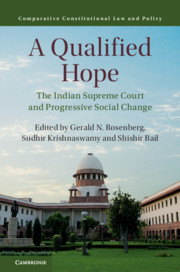Book contents
- A Qualified Hope
- Comparative Constitutional Law and Policy
- A Qualified Hope
- Copyright page
- Contents
- Notes on Contributors
- Foreword
- Acknowledgments
- Introduction
- Part I The Supreme Court of India – An Institutional Overview
- 1 The Structure and Functioning of the Supreme Court of India
- 2 The Supreme Court of India
- 3 The Recent Evolution of Public Interest Litigation in the Indian Supreme Court
- 4 Suo Motu Intervention and the Indian Judiciary
- 5 Public Trust in the Indian Judiciary
- Part II The Supreme Court of India, Social and Political Mobilization
- Part III Welfare Rights and the Environment
- Part IV Discrimination
- Conclusion
- References
4 - Suo Motu Intervention and the Indian Judiciary
from Part I - The Supreme Court of India – An Institutional Overview
Published online by Cambridge University Press: 19 August 2019
- A Qualified Hope
- Comparative Constitutional Law and Policy
- A Qualified Hope
- Copyright page
- Contents
- Notes on Contributors
- Foreword
- Acknowledgments
- Introduction
- Part I The Supreme Court of India – An Institutional Overview
- 1 The Structure and Functioning of the Supreme Court of India
- 2 The Supreme Court of India
- 3 The Recent Evolution of Public Interest Litigation in the Indian Supreme Court
- 4 Suo Motu Intervention and the Indian Judiciary
- 5 Public Trust in the Indian Judiciary
- Part II The Supreme Court of India, Social and Political Mobilization
- Part III Welfare Rights and the Environment
- Part IV Discrimination
- Conclusion
- References
Summary
This chapter examines the practice of the constitutional courts in India taking up matters suo motu (on their own initiative) without being petitioned by a claimant or party, to address a situation the judges regard as requiring extraordinary intervention on the part of the court. We assemble the available data about the incidence of this practice of suo motu intervention, its frequency, form, and results. We seek to explain why and how the Indian higher courts engage in this practice, and speculate about the effects of this practice on the courts and on Indian social and political life. For illustrative purposes, we describe the case of a recent intervention initiated by the Supreme Court, in response to a newschapter report of a gang-rape in a village a thousand miles away.
- Type
- Chapter
- Information
- A Qualified HopeThe Indian Supreme Court and Progressive Social Change, pp. 92 - 122Publisher: Cambridge University PressPrint publication year: 2019
References
- 2
- Cited by



